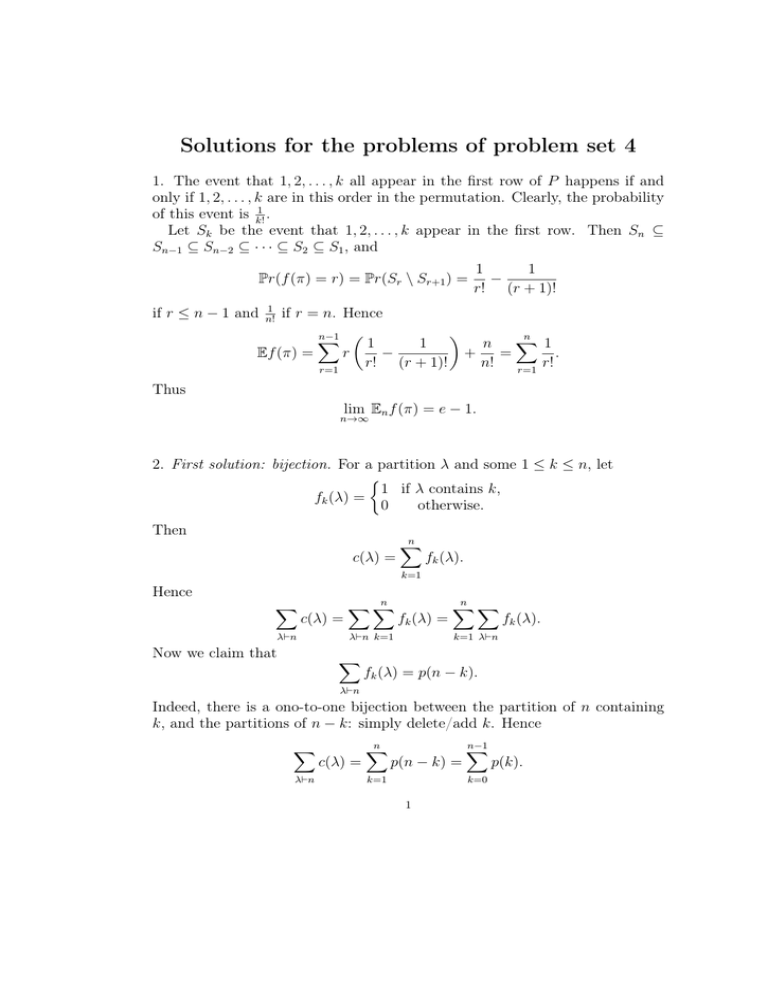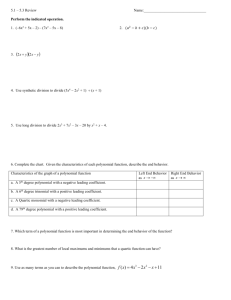Solutions for the problems of problem set 4
advertisement

Solutions for the problems of problem set 4
1. The event that 1, 2, . . . , k all appear in the first row of P happens if and
only if 1, 2, . . . , k are in this order in the permutation. Clearly, the probability
of this event is k!1 .
Let Sk be the event that 1, 2, . . . , k appear in the first row. Then Sn ⊆
Sn−1 ⊆ Sn−2 ⊆ · · · ⊆ S2 ⊆ S1 , and
Pr(f (π) = r) = Pr(Sr \ Sr+1 ) =
if r ≤ n − 1 and
1
1
−
r! (r + 1)!
1
n!
if r = n. Hence
n−1 n
X
X
1
1
n
1
Ef (π) =
r
−
+
=
.
r!
(r
+
1)!
n!
r!
r=1
r=1
Thus
lim En f (π) = e − 1.
n→∞
2. First solution: bijection. For a partition λ and some 1 ≤ k ≤ n, let
1 if λ contains k,
fk (λ) =
0
otherwise.
Then
c(λ) =
n
X
fk (λ).
k=1
Hence
X
c(λ) =
λ`n
n
XX
fk (λ) =
λ`n k=1
n X
X
fk (λ).
k=1 λ`n
Now we claim that
X
fk (λ) = p(n − k).
λ`n
Indeed, there is a ono-to-one bijection between the partition of n containing
k, and the partitions of n − k: simply delete/add k. Hence
X
λ`n
c(λ) =
n
X
p(n − k) =
k=1
n−1
X
k=0
1
p(k).
2
Second solution: hammer. Note that if we consider the bipartite subgraph of
the Young-lattice induced by the partitions of n and n − 1, then
X
c(λ)
λ`n
counts exactly the number of edges in this graph as the degree of a vertex λ is
exactly
c(λ). We know the eigenvalues of this bipartite graph: the eigenvalue
√
± k has multiplicity p(n − k) − p(n − k − 1). Since the number of edges is
half of the sum of the squares of the eigenvalues, we have
X
c(λ) =
λ`n
n
X
k(p(n − k) − p(n − k − 1)) =
k=0
n−1
X
p(k).
k=0
3. Note that
U n e∅ =
X
f λ eλ .
λ`n
We will use Theorem 8.4 of Stanley’s Algebraic Combinatorics to the word
W = wU n . Note that since w is balanced, the word W maps e∅ to the vectorspace induced by the partitions of n. Then
!
!
X
X
X
w
f λ eλ = wU n e∅ = W e∅ =
cW f λ e λ = cW
f λ eλ ,
λ`n
λ`n
λ`n
where
cW =
Y
`i ,
i
where the product goes over all D in W and, `i is the level at we are in the
Young-lattice before we go down by the i-th D step.
4. Let the planes be coordinized as follows
Hi = {(x, y, z) | ai x + bi y + ci z = di }.
Let us consider the following polynomial:
k
n
Y
Y
F (x, y, z) =
(ai x + bi y + ci z − di ) − δ
((x − i)(y − i)(z − i)) ,
i=1
i=1
where δ is chosen such a way that F (0) = 0. Since the planes does not cover
the point (0, 0, 0) we have δ 6= 0. If k < 3n then the maximum degree term
of F came from the second term: xn y n z n . Hence with the choice of sets
S1 = S2 = S3 = {0, 1, 2, . . . , n}, the combinatorial nullstellensatz would give
that there exists a (u, v, w) ∈ S1 × S2 × S3 for which F (u, v, w) 6= 0. But this
3
is impossible since F (0) = 0 and if (u, v, w) 6= 0 then both terms of F are 0.
This contradiction shows that k ≥ 3n.
5. We prove the statement by on induction on n. For n = 1 the claim is trivial.
Now assume that the claim is true till n − 1. Now let us use that
f (n−i,i) = f (n−1−i,i) + f (n−i,i−1)
because of the possible position of n in a standard Young-tableaux of shape
(n − i, i). This is true even if i = 0 or n − i = i by considering the second or
first term to be 0. Finally, note that be the hook length formula we have seen
that
f
(k,k)
2k
k
=
.
k+1
Now we are ready to carry out the induction. We will distinguish two cases
according to n = 2k + 1 or n = 2k. If n = 2k + 1 then
bn/2c
X
f
(n−i,i)
=
i=0
=2
k
X
k
X
f
(2k+1−i,i)
i=0
=
k
X
f (2k−i,i) + f (2k−i,i−1) =
i=0
f (2k−i,i) − f (k,k)
i=0
2k
2k + 1
n
2k
k
=
=
.
=2
−
k
bn/2c
k
k+1
If n = 2k then
bn/2c
X
f
(n−i,i)
i=0
=
k
X
f
(2k−i,i)
i=0
=2
k−1
X
i=0
f
(2k−1−i,i)
=
k
X
f (2k−1−i,i) + f (2k−i,i−1) =
i=0
2k − 1
2k
n
=2
=
=
.
k
k
bn/2c
Hence we are done.
6. We will show that any balanced word w can be written as a polynomial
of A = U D. Since p(A) and q(A) commute for polynomials p and q this
immediately implies the statement. We will prove our claim by induction on
the length w. If the length is 0, then the claim is trivial. If we proved for
length less than 2n then we simply do the following thing: we try to achieve
the order (U D)n by replacing U D by DU − I or DU by U D + I. Clearly we
can achieve any order of U ’s and D’s where there are n U ’s and D’s, and at
every changes we get some shorter word too:
w = (U D)n + linear combination of shorter words.
4
By induction the shorter words can be written as polynomials of U D so w can
also be written as a polynomial of U D.
7. Let us use Dyson’s identity for 3 variables, and let a1 = a, a2 = b and
a3 = c:
a a b b c c
x1
x1
x2
x2
x3
x3
1−
1−
1−
1−
1−
1−
.
x2
x3
x1
x3
x1
x2
This is
(x1 − x2 )a+b (x1 − x3 )a+c (x2 − x3 )b+c
(−1)b
.
a+c a+b
xb+c
1 x2 x3
To get the constant term we need to multiply the following terms from the
enumerator and then add them up:
c+k a−k
b+k b + c
b−k a+k
a−k a + c
b
a+k a + b
xc−k xb+k .
x x ·(−1)
x x ·(−1)
(−1) ·(−1)
b+k 2 3
c+k 1 3
a+k 1 2
a+c a+b
So the coefficient of xb+c
from one single term is
1 x2 x3
b+c
c+a
k a+b
(−1)
.
a+k
b+k
c+k
Since we know from the proof of Dyson’s conjecture that the coefficient of the
constant term is
a+b+c
,
a, b, c
we get that
a
X
b+c
c+a
a+b+c
k a+b
(−1)
=
.
a
+
k
b
+
k
c
+
k
a,
b,
c
k=−a
8. We will need a simple lemma.
Lemma. For any graph G one can partition the edge set E(G) into sets
B(v), where v ∈ V (G), such that if e ∈ B(v) then e is incident to v and
|B(v)| ≥ d(v)−1
.
2
Proof. We prove the claim by induction on the number of edges. So assume
that the claim is true for all graphs having less number of edges than G. We
prove the claim for G. First of all, we can ignore the isolated vertices, so we
will assume that every vertex has degree at least 1. If there is a vertex of
degree 1, say x then let y be its unique neighbor. Then let us delete the edge
(x, y). By induction, there is a partition of the edges satisfying the conditions
5
of the lemma for the obtained graph. Then add the edge (x, y) to the set B(y).
It is easy to see that the new partition satisfies the conditions of the lemma.
Next assume that every degree is at least 2. Then G contains a cycle (why?),
let v1 v2 . . . vk be the vertices of the cycle. Delete the edges of the cycle from the
graph. Now by induction there is a partition of edges satisfying the conditions
of the lemma for the obtained graph. Now add the edge (vi , vi+1 ) to the set
B(vi ) (when i = k then i + 1 = 1). It is easy to see that the new partition
satisfies the conditions of the lemma for the graph G. Hence we are done.
Having this lemma we can easily finish the proof of the problem. Let us
consider the following multivariate polynomial. Let R(v) = {0, 1, . . . , d(v)} \
D(v), and for every edge e let us associate a variable xe . Then let
!
Y Y
X
P (xe | e ∈ E) =
xe − j .
v∈V j∈R(v)
It is clear that P has degree
X
e: v∈e
(d(v) + 1 − |D(v)|).
v∈V
Note that |R(v)| = d(v) + 1 − |D(v)| ≤ |B(v)| as |D(v)| ≥ d(v)
+ 1 and
2
d(v)−1
1
|Bv | ≥ 2 , so |D(v)| + |B(v)| ≥ d(v) − 2 , and since integer we have |D(v)| +
|B(v)| ≥ d(v). So let us choose subsets S(v) ⊆ B(v) such that |S(v)| =
d(v) + 1 − |D(v)| = |R(v)|. Then the term
Y Y
xe
v∈V e∈S(v)
is a max degree Q
term, and its coefficient is clearly positive by the lemma,
namely at least v∈V |R(v)|!, and the fact that a max degree term cannot
contain a −j term from any product. Hence we can apply the combinatorial
nullstellensatz with sets Ae = {0, 1}: there exists some vector (xe )e∈E(G) ∈
{0, 1}E such that P (xe | e ∈ E) 6= 0. Let H be the spanning subgraph for
which e ∈ E(H) if xe = 1. Then H satisfies the condition of the problem.
9. Let
Pn (x) =
n n o
X
n
k=1
k
xk .
First we show that
nno
k
=
n−1
k−1
+k
n−1
k
.
6
This is indeed true since if we decompose {1, 2, . . . , n} into k sets then we can
distinguish two cases according to n is a set itself or not. If it is a set then
we
have to decompose {1, 2, . . . , n − 1} into k − 1 sets which we can do in n−1
k−1
ways. If it is not a set then we have to decompose {1, 2, . . . , n − 1} into k sets
and then we can put n into k sets.
Then
Pn (x) =
n n o
X
n
k=1
k
k
x =
n X
n−1
k=1
k−1
+k
n−1
k
0
xk = x(Pn−1 (x)+Pn−1
(x)).
Now we are ready to prove by induction that Pn (x) has only real zeros. This
is true for n = 1 as P1 (x) = x. We show that if P (x) has only real zeros then
Q
so does P (x) + P 0 (x). Indeed, if P (x) = ki=1 (x − αi ), then
!
k
0
X
P
(x)
1
P (x) + P 0 (x) = P (x) 1 +
= P (x) 1 +
.
P (x)
x − αi
i=1
Now if z = a + bi then
k
X
!
k
X
z − αi
P (z) + P 0 (z) = P (z) 1 +
= P (z) 1 +
|z − αi |2
i=1
i=1
!
k
X
a − αi − bi
= P (z) 1 +
.
|z − αi |2
i=1
1
z − αi
!
=
Now if z is not real then P (z) 6= 0, and
!
k
k
X
X
b
a − αi − bi
=
6= 0.
= 1+
2
2
|z
−
α
|
|z
−
α
|
i
i
i=1
i=1
So it cannot be zero either. Hence P (x) + P 0 (x) has only real zeros. This
implies that Pn (x) has only real zeros for every n by induction.
The second claim follows from Newton’s inequalities and the fact that Pn (x)
has only real zeros.
10. Assume that the set A = {Pi = (ai , bi ) | 1 ≤ i ≤ k} intersects all lines,
and assume that k < 2p − 1.
Let us complete the affine plane to a projective plane. This is just a technical
trick which simplifies the proof. Then the coordinates of the point Pi are
(ai , bi , 1). Then these points intersect all lines in the projective plain except
the ideal line with coordinates [0, 0, 1]. Recall that a point P with coordinates
(a, b, c) is on a line of parameters [u, v, w] if au + bv + cw = 0.
7
Let us consider the following polynomial
P (x, y, z) =
k
Y
(ai x + bi y + z) − z t (xp−1 − 1)(y p−1 − 1),
i=1
where t = k − (p − 1) or k accrording to k > p − 1 or k ≤ p − 1. So
1 ≤ t ≤ p − 1. If k < 2p − 1 then the maximum degree term of this polynomial
is xp−1 y p−1 z t . Then we can apply the combinatorial nullstellensatz with sets
S1 = S2 = S3 = Fp , and get that there exists a (p, q, r) ∈ F3p such that
P (p, q, r) 6= 0. But this is impossible since if p or q is not 0 then the second
term is 0 just like the first term since the set A intersects all lines of the affine
plane. If p = q = 0 then P (0, 0, r) = rk − rt = 0 by the choice of t. This
contradiction shows that k ≥ 2p − 1.
11. First solution: with Dyson’s identity. Let x1 , . . . , xk be variables. Every
computation will be carried out in the field Fp . Let us consider the following
polynomial:
!
!
Y
Y
Y
Y
Y
P (x) = (xi − xj ) (xi + di − xj ) (xi − di − xj + dj )
xi
(xi − di ) .
i<j
i<j
i6=j
i
i
If there exists some a = (a1 , . . . , ak ) for which P (a) 6= 0 then it means that
together with the numbers bi = ai − di we have that (ai , bi )i=1,...,k are all
different and they are not 0. So we would like to apply the combinatorial
nullstellensatz with sets Ai = Fp for i = 1, 2, . . . , k}. Note that
deg P = k(k − 1)/2 + k(k − 1) + k(k − 1)/2 + 2k = 2k 2 = k(p − 1).
So it is enough to prove that the coefficient of x1p−1 . . . xp−1
is not zero in Fp .
k
Note that since it is a max degree term, this coefficient is the same as the
coefficient of
!4
!2
Y
Y
(xi − xj )
xi .
i<j
i
Of course, it is the same as the coefficient of x1p−3 . . . xp−3
in
k
!4
!2
Y
Y
(xi − xj ) .
(xi − xj ) =
i<j
i6=j
But this is exactly the polynomial we studied at Dyson’s conjecture and we
noted that the the coefficient of x1p−3 . . . xp−3
is
k
(2k)!
(p − 1)!
=
6= 0.
2! . . . 2!
2! . . . 2!
8
We are done.
Second solution: without Dyson’s identity. Let x1 , . . . , xk be variables. Every
computation will be carried out in the field Fp . Let us consider the following
polynomial:
!
!
Y
Y
Y
Y
Y
P (x) = (xi − xj ) (xi + di − xj ) (xi − di − xj + dj )
xi
(xi − di ) .
i<j
i<j
i6=j
i
i
If there exists some a = (a1 , . . . , ak ) for which P (a) 6= 0 then it means that
together with the numbers bi = ai −di we have that (ai , bi )i=1,...,k are all different
and they are not 0. To show that there exists some a for which P (a) 6= 0 it is
enough to show that
Z
X
P (a) 6= 0.
P =
a∈Fn
p
Now let us use the observation of problem P2. Note that
deg P = k(k − 1)/2 + k(k − 1) + k(k − 1)/2 + 2k = 2k 2 = k(p − 1).
So the value of the integral depends on the coefficient of the term xp−1
. . . xp−1
1
n ,
0
in particular it is independent of the numbers di Let P be the polynomial where
we choose di =R 1 in P everywhere. Then it is easy to see that that the only nonzero terms in P 0 are the ones where ai ’s form the set S = {2, 4, 6, . . . , p − 1}.
In addition all permutations of the ai ’s give the same non-zero element:
!
!
!
!
Y
Y
Y
Y
(i + 1) .
i
(i − j)2
(i + 1 − j)
r=
i6=j∈S
Thus
R
P =
R
i,j∈S
i∈S
i∈S
P 0 = k!r 6= 0 so there exists an a for which P (a) 6= 0.
Remark: This result is due to Karasov and Petrov. The historical interest
lies in the fact that the paper containing this result and the comparison of the
above two different proofs lead Gy. Károlyi and Z. Nagy to the proof of the
q-Dyson’s identity we learned at the lecture.







